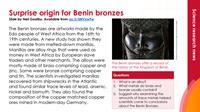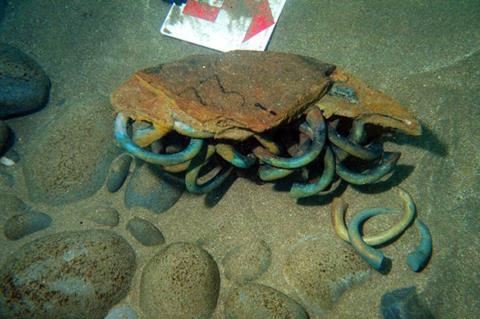Geochemical analysis reveals surprise insights into early Atlantic trade routes
-

Download this
Use this story and the accompanying summary slide for a real-world context when studying alloys with your 14–16 learners.
Download the story as MS Word or PDF and the summary slide as MS PowerPoint or PDF.
Geochemists have confirmed that most of the Benin bronzes – sculptured heads, plaques and figurines made by the Edo people in West Africa between the 16th and 19th centuries – are made from brass that originated thousands of miles away in the German Rhineland.
The surprising discovery casts new light on the artworks, many of which were looted by British forces during the military expedition of 1897 that brought the Edo’s Kingdom of Benin to an end. The Kingdom of Benin is separate from the modern republic of Benin, and its territories were eventually absorbed into Nigeria.

An estimated 5000 Benin bronzes are held in art collections around the world, including at the British Museum in London and The Met in New York. Nigeria has asked for repatriation, but fewer than 100 have been returned so far.
Metal detectives
Tobias Skowronek, a geochemist at the Technische Hochschule Georg Agricola in Bochum, Germany, led the new study. He says it was long suspected that metal used for the artworks was melted-down manillas that the Portuguese brought to West Africa. But where those manillas were originally purchased and where the metal was mined wasn’t known, he says.
Manillas are horseshoe-shaped copper alloy bracelets. They were used as money in West Africa by European slavers and traders from the 16th century onwards. The copper was usually alloyed with zinc to make brass. During that era, people often referred to the metal as bronze, a name more typically used to describe copper–tin alloys.

To determine the origins of the metal in the Benin bronzes, Tobias and his colleagues analysed 67 manillas known to have been used in early Portuguese trade. The manillas were recovered from five shipwrecks in the Atlantic and three land sites in Europe and Africa. The scientists determined the lead isotope signatures of the manillas, and determined the amounts of other trace impurities in the brass such as antimony, arsenic, nickel and bismuth.
Tobias’ team found strong similarities between the manillas studied and the metal used in more than 700 Benin bronzes with previously published chemical compositions. The team also found the chemical composition of the copper in the manillas matched copper ores mined in northern Europe, which suggests that modern-day Germany, specifically the German Rhineland, was the main source of the metal.
This article is adapted from Tom Metcalfe’s in Chemistry World.
Nina Notman
Reference
T B Skowronek et al, PLOS ONE , 2023, DOI: 10.1371/journal.pone.0283415
Download this
Summary slide with questions and the article for context when teaching your 14–16 classes on metal alloys: rsc.li/43ReZAP
Downloads
EiC summary slide Benin bronzes
Presentation | PowerPoint, Size 2.01 mbEiC summary slide Benin bronzes
Presentation | PDF, Size 0.31 mbEiC science research story Benin bronzes
Handout | Word, Size 0.58 mbEiC science research story Benin bronzes
Handout | PDF, Size 0.22 mb














No comments yet